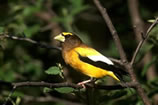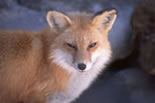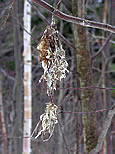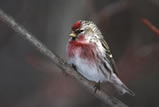
Nature Journal
| |
||
| Friday, December 26, 2003 | ||
 A
group of nine wild turkeys walked
by the house this morning. I only noticed one that had a beard. The
others must have been females or juvenile males. In the winter, adult
males will sometimes join a family group consisting of a female A
group of nine wild turkeys walked
by the house this morning. I only noticed one that had a beard. The
others must have been females or juvenile males. In the winter, adult
males will sometimes join a family group consisting of a female |
||
|
There was a flock of about 20 evening grosbeaks below my feeder yesterday. This was their first visit since I originally saw them on the 14th. A couple of days ago, the first juncos of the year put in an appearance. They were eating weed seeds from the ground near the house. There were a lot of other birds under the feeder, so perhaps they were waiting their turn. The common redpolls have been visiting the feeder almost every day since I first saw them on the 14th. |
||
| Wednesday, December 24, 2003 | ||
| I
haven't seen any wild turkeys for
a long time. But today I saw some turkey tracks. Quite a few of them. My neighbors have been seeing ruffed grouse fairly frequently over the past week or two. But no sign of them in my area. I just watched two deer walking through the snow behind my house. We're having rainy, foggy weather - so I couldn't see them very clearly. One deer was noticeably smaller than the other, so I suspect it was a doe and her grown fawn. |
||
| Sunday, December 21, 2003 | ||
 I
heard the barred owl calling again
a couple of nights ago. I
heard the barred owl calling again
a couple of nights ago.When I was out walking today, I noticed a lot of deer tracks in the snow. So I guess they're out and about again. |
||
I also saw the tracks of the red fox. Some tracks were direct-registering (where the hind foot falls directly in the track of the front foot). This is the red fox's walking pattern. Other tracks were in the 2-2 pattern that is seen when a fox is trotting. |
||
| Thursday, December 18, 2003 | ||
| In
the early mornings, I've been hearing the nasal "nyah, nyah,
nyah, nyah..." call of the red-breasted
nuthatch. This little bird is one of my favorites. This afternoon, I saw two ravens flying above the treetops. They were alternately flapping their wings and soaring. Ravens can be distinguished from crows by their heavy bills. Also, crows don't soar. At first, these two ravens were making hoarse "kraaah" calls and then later I heard their "kolp, kolp" calls. |
||
| Tuesday, December 16, 2003 | ||
|
|
||
in the more sheltered areas now. With the snow being so deep, it makes travel a lot harder for the deer. I did see a lot of squirrel tracks, mice tracks, and the tracks of an unidentified medium-sized bird. |
||
| Sunday, December 14, 2003 | ||
| Yesterday,
a flock of about 10 evening grosbeaks
visited my feeder. First there was just one, calling "peeer,
peeer" from the top of the feeder pole. Then about fifteen minutes
later, the whole flock arrived. A smaller flock of common redpolls also stopped by. Both groups were mostly feeding on the ground below the birdfeeders. In the past, I've rarely seen either of these species at the feeder - and then only one or two birds at a time. So this was a pleasant surprise! |
||
| Friday, December 12, 2003 | ||
 In
October of last year, I noticed this bird's
nest. I watched it over the next 10 months or so - to see if another
bird or any other little creature would make use of it. There weren't
any signs of anything happening during that time, so I stopped watching
it. In
October of last year, I noticed this bird's
nest. I watched it over the next 10 months or so - to see if another
bird or any other little creature would make use of it. There weren't
any signs of anything happening during that time, so I stopped watching
it.Today, I saw the remains of this nest hanging from a branch. I suspect that the |
||
| Tuesday, December 9, 2003 | ||
|
I put
my birdfeeders out a couple of days ago. So far, I've been seeing
chickadees, white-breasted
nuthatches, red-breasted nuthatches, goldfinches, and blue jays. |
||
| Top of page | ||
|
|
| Birds | Butterflies | Mammals |
| Garden Shop |
New England:
Connecticut, Maine, Massachusetts, New Hampshire, Rhode Island, Vermont
 Have
been seeing more
Have
been seeing more